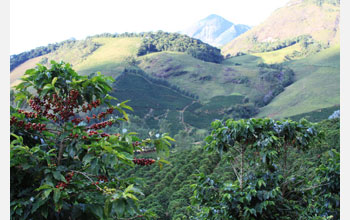Habitat
Ophiocordyceps unilateralis
enjoys a warmer habitat and is normally found in tropical
environments (Hughes 2010). The fungus may be found in warm temperate forests,
but is more commonly found in tropical forests in Thailand,
Brazil, Central America, and Africa (Cordyceps 2013). O.
unilateralis requires a habitat with large forests likely
abundant with its main food source, the ants it infects and
kills. Since the subspecies of O. unilateralis each
have their own species of ant that they infect, the habitat will
depend on where the specific hosts are located (Hughes 2010). This would
explain why the fungus is able to live in many different
tropical regions.
The zombie ant fungus elicits a very specific response once
in control of the host ant (Hughes 2010). This response is to direct the ant
away from its nest and to have it find an area best suited for
fungal reproduction (Than 2011). The majority of
fungus-sprouting ants were found in areas with temperatures
between 20 and 30 degrees celsisus (Than 2011).
 The conditions described would
be well suited for fungal growth, and it is quite amazing how
the fungus has the ability to manipulate the ant to find an area
with such conditions.
The conditions described would
be well suited for fungal growth, and it is quite amazing how
the fungus has the ability to manipulate the ant to find an area
with such conditions.
The infection mainly occurs in the understory roughly 25
centimeters from the soil (Hughes 2010). The ants are normally high in the
canopy, but certain ants deviate from the normal trail and fall
to the understory. Once in the understory, the ants quickly
become infected and stay in this cool, moist environment (Hughes
2010). The conditions of the understory are perfect for fungal
growth, and once the host species moves to the understory for
food it can become infected.
A recent study has shown that O. unilateralis has
been interacting with insects for millions of years (Hughes
2010). In an
article by David Hughes a fossil sample was found in The Messel
Pit in Hesse, Germany that showed the bite marks in leaves, a
characteristic unique to the interactions between the zombie ant
fungus and its host ant (Hughes 2010). The fossil site dates
back to 48 million years ago showing that the fungus has moved
its habitat over time (Hughes 2010).
The rainforests are host to a variety of different organisms. To learn more about the rainforest and the organisms that call it home, click here!